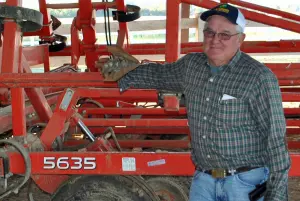Arkansas Grower Relies Heavily on His Pair of 5635 Field Cultivators

Wheatley, Ark., soybean and rice grower Hubert Ragsdale is impressed with the heavy-duty build of his two 5635 field cultivators from KUHN Krause.
“It had all the features I thought it should have,” says Ragsdale of when he went to purchase the new field cultivators this past spring.
Ragsdale, a 67-year-old lifelong farmer, farms in northeast Arkansas between Little Rock and Memphis, Tenn. This year he has 2,300 tillable acres, 810 of them in rice with the balance in irrigated soybeans.
He operates Double R Farms, Inc., with his wife Rita and three employees, two full-time and one part-time. Ragsdale is a third-generation farmer who has been growing rice and soybeans for 48 years.
“I did a little wheat back in the ‘90s – double-cropped and went to no-till,” he says, admitting neither worked well for him and he abandoned that third crop as well as no-till.
Relying on furrow irrigation for both crops, he says no-till “doesn’t work here” because of water table challenges and a “salt problem” in the water. Not stirring that soil enough makes the tender rice seedlings susceptible to damage, he explains.
His rotation is two years of soybeans, a year of rice and back into beans for two more years. Ragsdale plants soybeans starting in mid-April and likes to be finished by May 10.
“This year is pretty remarkable,” he notes of his 2013 harvest. His beans ran 55 to 70 bushels.
This is the first time he has ever seen a yield that high. His five-year average is more like 55 bushels.
“I need 55 to 60 bushels to stay in business,” notes this farmer. He relies on his two, 34-foot KUHN Krause 5635 field cultivators to condition the soil and create an optimum seedbed for planting, allowing him to reach the kind of yield potential that he is achieving.
He has run each of his 5635 field cultivators across 2,300 acres apiece this year.
“I worked the whole place twice,” he notes. “They do an excellent job and they pull easy,” says Ragsdale, who has lighter silt loam soil.
He really likes the K-Tine shank mount, which has no pivots or bushings. The vibrating action moves residue and shatters any surface compaction.
Other advantages are the following:
Uniform cultivation with this field cultivator’s Split-the-Middle sweep pattern for better seed-to-soil contact.
Uniform tillage depth for consistent moisture within the tillage profile, which provides more even stand germination and emergence
A smooth, level seedbed surface that helps prevent planter row unit bounce, ultimately giving more consistent seed spacing and planting depth.
Earlier warming of the soil, which helps widen that planting window.
“It’s our primary tillage unless it’s really wet,” he notes of running a disc across the rice stubble and then the field cultivator. He fertilizes and pulls the field cultivator over the ground again, then plants.
Ragsdale’s field cultivators have the self-leveling hitch. They feature mechanical depth control on each tandem. A gauge wheel is standard for each wing section making for precise depth control.
As noted, Ragsdale furrow-irrigates his soybeans, providing the crop with water about every eight days when it’s really dry. The area in which he farms is “really hot and dry,” he notes. Soybeans grow in 38-inch beds. He beds beans after sowing them, hence the need for field cultivation, he explains. He plants 43 pounds of 3,000-count seed to the acre.
“I plant rice the same way,” he continues. He pulls his 5635 field cultivators once to prepare the ground and a second time to prepare the seedbed.
“Design is everything when it comes to farm equipment, and by far, this KUHN Krause field cultivator had the best design,” he says of the comparison shopping he did. “The frame has been reinforced and it has larger bearings and heavier ply tires. That might seem like a trivial thing, but this equipment is really heavy when you go down the road. Ours have rolling baskets on the back, which adds to the weight.”
“It’s amazing how much trouble I had with my old machines (the field cultivator brand he replaced with the KUHN Krause 5635). I had wheel bearings go out. They (his former cultivators) just were not designed to carry the baskets. They could not handle the weight well,” says Ragsdale.
The KUHN Krause 5635 bridge frame has 2- by 2-inch rear members stacked on 3- by 4-inch side-to-side beams, with lapped welds for maximum strength and extended frame life. It’s a field-proven design that is stronger than conventional frames.
Another notable feature on the 5635 series is the gauge wheels, which are linked to the ratchet depth adjustment and eliminate the need for separate adjustments, saving producers precious time.
Ragsdale purchased his pair of 5635 field cultivators from Hobbs Implement in Colt, Arkansas.
“They’re great people,” he states without hesitation. “They’ll do what they tell you they’ll do.”
“I think these (from KUHN Krause) will be a long-life piece of equipment,” he surmises from what he sees as both a smart design and rugged build.
